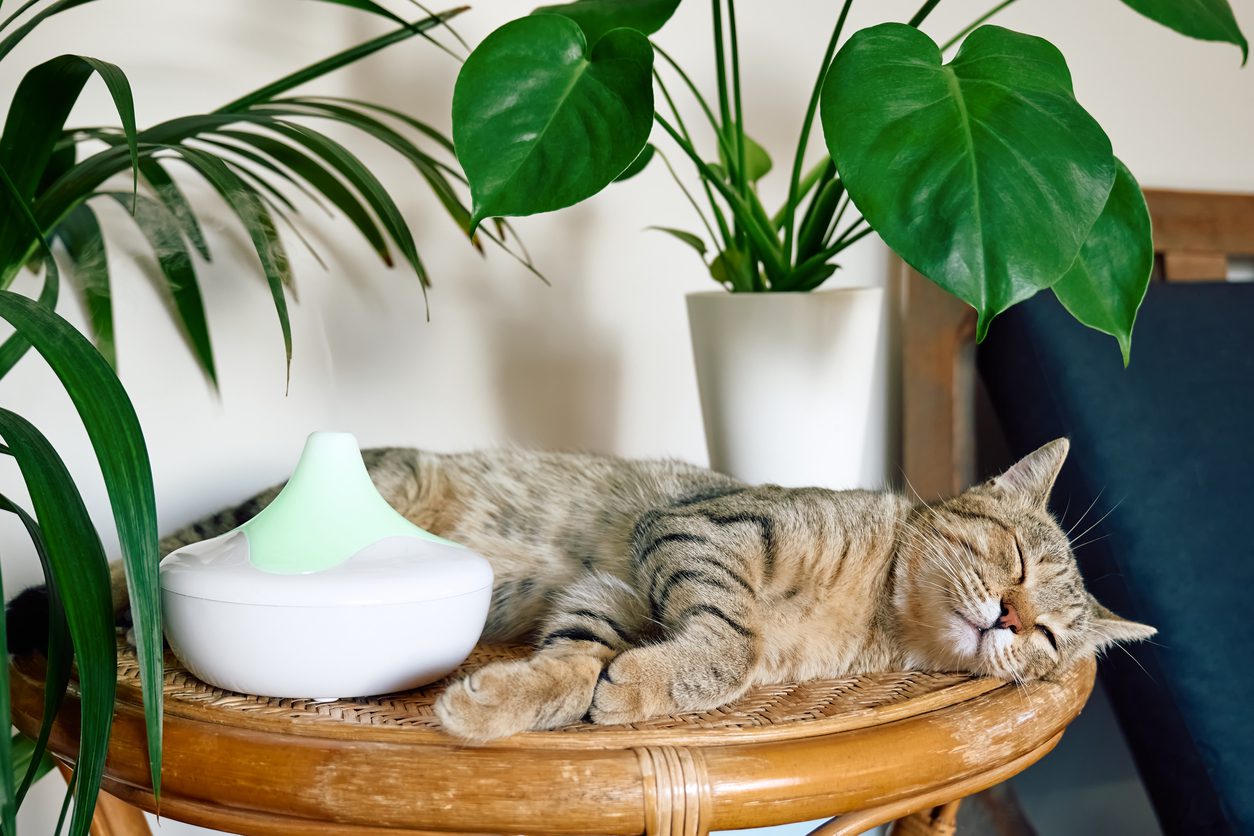Millions of people use aromatherapy daily to boost mood, relieve anxiety, and improve sleep. And the scents themselves are very pleasing. But do the essential oils used in aromatherapy pose health risks to your cats? If you’re a cat owner and use aromatherapy products, there are some important cautions you should know about.
What are essential oils?
Aromatherapy works using compounds obtained from plants. These natural compounds are then refined and purified into highly concentrated oils—each drop of essential oil may contain compounds from hundreds to thousands of individual plants. These oils are then commonly diluted for household use in aromatherapy diffusers. Some, however, are sold in undiluted form and because of their potency these can be especially dangerous to cats.
How do essential oils work?
In aromatherapy, the desired essential oil is placed in a diffuser, which sends microparticles of the oil in a fine mist throughout the immediate environment. While these oils may be beneficial for humans, many contain compounds that are dangerous for cats. There are several types of diffuser, but those that use heat to warm the oil create compounds that are toxic to cats and can generate sufficient exposures to pose a real risk. Reed diffusers use osmosis to draw far smaller amounts of essential oils into the environment. The reduced exposure and absence of heat make reed diffusers preferable for cat owners.
What is the risk to cats?
The essential oils used in aromatherapy contain specific compounds called terpenes, ketones, and phenols, which are dangerous to cats. Cats’ bodies lack the enzymes necessary to process and safely excrete these compounds. As a result, these substances can accumulate in the liver or kidneys, sometimes to lethal levels.
Some popular fragrances containing terpenes, ketones, and phenols include:
- Bergamot
- Bitter almond
- Cinnamon
- Citrus
- Cloves
- Eucalyptus
- Juniper
- Mint
- Rose
- Sandalwood
- Tea Tree
- Thyme
- Wormwood
Without timely intervention, feline overexposures to these oils can be fatal.
All Essential Oils Are Not Alike
Essential oils are used in many products outside aromatherapy. That does not mean, however, that if you see tea tree oil as an ingredient in pet shampoo that you can give tea tree essential oil to your pet. Concentrations of these oils can vary profoundly from product to product, and those used in some may far exceed safe tolerance levels for cats. Also, the way these oils are prepared can include agents that should not come into contact with pets.
Ways Cats Can Be Exposed To Essential Oils
There are several ways that your cat could come into contact with these substances contained in essential oils. A toppled diffuser, for example, can create a significant exposure risk to your pets. So let’s review the most common types of toxic exposure to essential oils.
Skin. Cats can readily absorb oils that come into direct contact with the skin. And because essential oils are so concentrated, even a skin exposure can become problematic. Essential oils also contain agents that are potential irritants to your feline’s skin. If you suspect a skin exposure, clean the area with a mild liquid dish detergent and water then contact your vet.
Inhalation. Cats are curious animals, and will likely want to check out that new diffuser. While inhalation accidents are rare, they’re not unheard of, especially among cats with respiratory conditions. Contact your vet if your pet has trouble breathing and you suspect an essential oil is the cause.
Oral consumption. The greatest risk for toxic exposure comes from direct consumption. If you suspect that your cat has eaten essential oils, contact your vet immediately.
What are the signs of toxic exposure?
The symptoms of toxic exposure to essential oils in cats can vary in both nature and severity. Common symptoms include:
- Excessive drooling
- Vomiting
- Tremors
- Trouble walking (“drunk walking”)
- Seizures
- Trouble breathing
- Physical collapse
If your cat displays any or a combination of these symptoms, contact your vet immediately. In toxic exposure cases, time is critical.
What should you bring to the vet?
In cases of pet poisoning, it’s helpful for your vet to know:
- Exactly what agent your cat was exposed to (bring package labeling if possible)
- The nature and amount of exposure
- Your pet’s medical history
- Your pet’s size and weight (kittens and small cats are more vulnerable to toxic overexposure)
Your vet will need to run some tests to assess any potential damage to your pet’s liver or kidneys.
Conclusion
As cat lovers we encourage you to always be safe when using any potentially harmful product around your pets. Remember to store aromatherapy products securely and to keep diffusers away from curious felines. If you have questions, or suspect that your cat has been exposed to a toxin, call your vet immediately.
